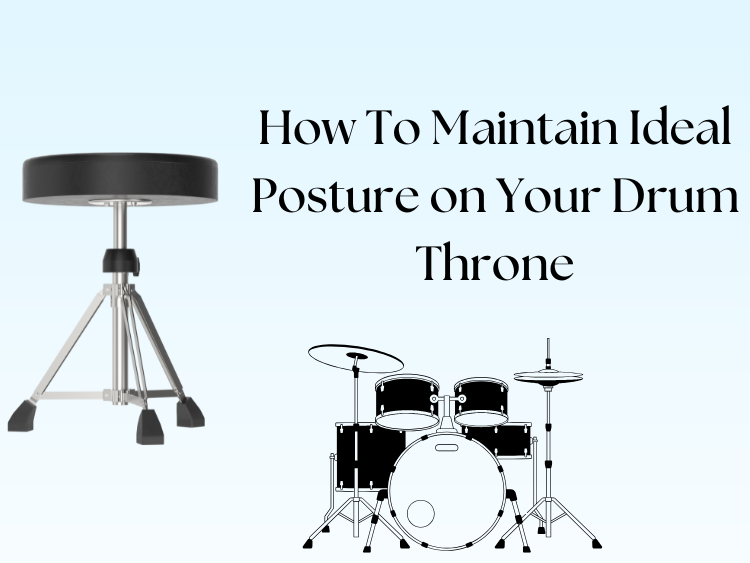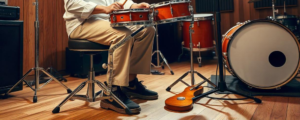A drum throne may look like a simple piece of gear, but it is very important for keeping your back straight while playing the drums. Many drummers ignore how much their seat might affect their comfort, technique, and general health. Correct sitting helps avoid long-term back problems, leg cramps, and other physical discomforts. This article will go over how to modify your drum throne to get ideal posture, so improving your performance and general well-being.
Why Is Proper Posture Important for Drummers?
Drummers should first be aware of why good posture is important before delving into the modifications. Drumming calls for both fine motor skills and physical endurance. Poor technique, more muscle strain, and even long-term injuries including back pain, carpal tunnel syndrome, or knee issues can result from incorrect sitting.
Keeping a neutral and balanced posture guarantees that your joints and muscles are not overused, enabling you to play for long stretches without pain. Good posture also improves your technique for playing. Your body will be in line and you will be able to move more quickly and freely. Smoother performance, better accuracy, and more drumming control follow from this.
The Anatomy of a Drum Throne
A drum throne is made of several movable parts that are all quite important for keeping comfort and good posture during drumming. The height change lets you raise or lower the seat to fit your playing style, so preserving the natural posture of your legs and feet. The tilt of the seat, which might affect your posture and general comfort, is set by the seat angle. Changing the seat depth alters the support your thighs get, so avoiding discomfort and problems with circulation. Certain thrones include built-in backrests that give extra lumbar support, so preserving a good spine posture. Correct alignment, less strain, and increased endurance resulting from appropriate changes to these elements help to enable longer and more comfortable playing sessions. Understanding how to choose the perfect drum throne for your needs can make a big difference in comfort and performance.
Step-by-Step Guide to Maintaining Posture
Regarding drumming, comfort and performance depend on the correct posture. The length of time you can play without pain or strain will be much influenced by a correctly tuned drum throne. Use this exacting step-by-step guide to modify your drum throne for improved posture and a more comfortable drumming experience. For help in selecting the right option, consider this drum throne buying guide to find the best fit for your playing style.
1. Set the Right Height
Your drum throne’s height will greatly affect your sitting posture and body contact with the drums.
a. Sit on the throne: Start by comfortably seated with your feet flat on the ground. Your thighs should be either gently sloping downward or roughly parallel to the floor. This will help you to maintain a neutral spine posture, straightening your back and so preventing needless strain.
b. Adjust the height: Most drum thrones include a pneumatic or screw-style height adjustment. Beginning with a height where your knees are bent at a 90-degree angle or somewhat more open, set the throne.
c. Feet placement: Your feet should readily reach the pedals without your knees being either too high or too low. Your body will be pushed to slink forward or hunch over to reach the pedals if your knees are too high, so stressing your lower back. Your legs may tire rapidly if your knees are too low, and you won’t have the necessary leverage for pedal control.
d. Test the height: After adjusting initially, sit down once more to make sure your thighs are relaxed and parallel to the floor and your feet can easily reach the pedals. Play a few beats to see if over time the height feels reasonable.
2. Adjust the Seat Angle
An important part of making sure you have good posture is the angle of your seat. Should the seat be overly forward or backward, it can cause discomfort, compromise your balance, and complicate your ability to preserve a natural spinal curve.
a. Neutral tilt: The seat should ideally be level or slightly forward-tipped from neutral. A modest forward tilt promotes better lumbar support and helps to avoid slouching. It also lets you sit on the throne with your back straight.
b. Avoid backward tilt: Should the seat be slanted too far back, your pelvis will tilt backwards, causing hunched posture and extra strain on your spine. Lower back discomfort over time can follow from this.
c. Test the tilt: Sit on the throne and change the seat angle until your pelvis naturally slants somewhat forward. This promotes correct spinal alignment and lessens back pain risk. Try playing for a few minutes to see whether your lower back feels more relaxed or tense if you’re not sure.
3. Adjust the Seat Depth
Long drumming sessions will feel more or less comfortable depending on the depth of your drum throne seat. While too little depth can give inadequate support, too much seat depth can cause your legs to be pushed forward, restricting circulation. Finding the right balance is key, as even rock legends’ drum thrones are carefully chosen to enhance their performance and endurance.
a. Find the right depth: The perfect seat depth guarantees a pleasant gap between the back of your knees and the seat edge. Pressure behind your knees should not be felt; this will restrict blood flow and over time cause pain.
b. Adjust for comfort: If your throne lets you make depth changes, start small until you find a position where the seat gives complete support without feeling too tight or loose. Your legs should stay free from any unwarranted pressure from the seat’s edge.
c. Comfortable seating: If your seat has a cushioning or contouring element, make sure it naturally shapes your body. A well-cushioned seat helps you play more comfortably over longer stretches by lowering pressure points.
4. Ensure Proper Foot Placement
As drumming gear continues to evolve, future drum throne innovations may further enhance stability and comfort, helping drummers maintain better posture and technique. Correct posture and control on the drums depend on good foot placement. Inappropriate foot placement can cause knee strain, leg cramps, or trouble efficiently riding the pedals.
a. Feet flat on the floor: Depending on your drumming arrangement, your feet should be flat either on the floor or the foot pedals. Dangling or raising your feet too high will tax your leg muscles and impede pedal control.
b. Adjust throne height for pedal control: Change throne height to suit pedal control. Without effort, your feet should comfortably reach the bass drum and hi-hat pedals. Make sure your feet don’t stretch too far to reach the pedals and your knees stay relaxed.
c. Footrest positioning: Should your throne feature a footrest, it can add even more comfort. Particularly in long sessions, your feet should rest naturally on the footrest. This will prevent tiredness and help you keep equilibrium.
5. Focus on Back Support and Alignment
Maintaining correct posture while drumming depends on good back support. Particularly in the lower back, lack of back support can cause muscle tiredness.
a. Sit upright: Your back should be straight when you’re sitting down, not arched or hunched. By strengthening your core muscles, you can prevent slumping and preserve good posture.
b. Posture check: Check your posture often while you play. Make sure your shoulders aren’t tight but rather relaxed. Do not lean forward to reach the drums or pedals. This will hurt your back and make it harder to play the drums properly.
c. Lumbar support: A few drum thrones feature adjustable lumbar support or built-in backrests. Particularly if you have lower back discomfort, these can help. Change the backrest to help your lumbar spine without straying from a natural posture.
Conclusion
One easy but powerful approach to improve your drumming experience and avoid long-term physical problems is changing your drum throne for better posture. Playing for hours without discomfort is possible by concentrating on the proper height, seat angle, depth, foot placement, and back support. Recall, balance is the secret to good posture. Your seat should be changed to let you sit relaxed and straight with simple access to your drums and pedals. These little changes will help you keep a better playing posture over time, improving performance, lowering strain, and increasing enjoyment. Please don’t forget how important your drum throne is. Choosing from the top drum thrones of 2025 can also ensure better support and durability for long-term comfort. Investing in a quality option like the DW 9000 Series Airlift Throne, 5CORE Heavy-Duty Drum Throne, Gibraltar Pro Oversized Throne, or Roc-N-Soc Nitro Throne can make a big difference in comfort and support. Your body will thank you later!




